It looks like you're using an Ad Blocker.
Please white-list or disable AboveTopSecret.com in your ad-blocking tool.
Thank you.
Some features of ATS will be disabled while you continue to use an ad-blocker.
share:
In looking at Pre-Buddhist into early Buddhist iconography of Tibet with regards to the premise of stargate cultural elements i'll be basing this
along the same lines that i outlined here in the closely related, as shall be seen, model for the 'Stargates of Iran'
www.abovetopsecret.com...
The premise for this model is of a stepped/layered thought system that formed the basis for these cultures, involving progression from natural observance, though to metaphorical/sexual/mythological interpretation, then to cosmological with upper levels involving advanced mathamatical/technological potentialities.
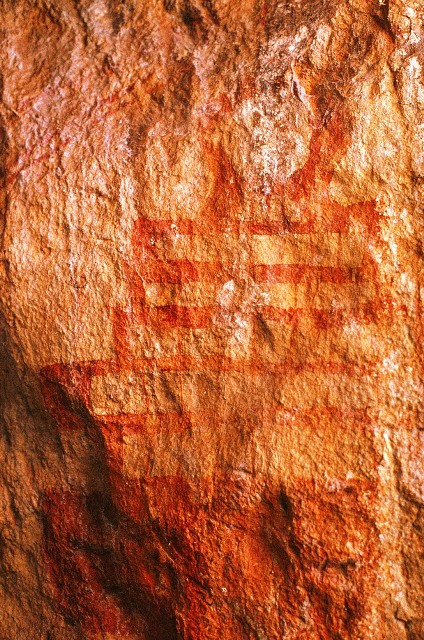
The basic marker then for civilizations that were developed along this model is that of the stepped symbol and that is were we shall begin for Tibet.
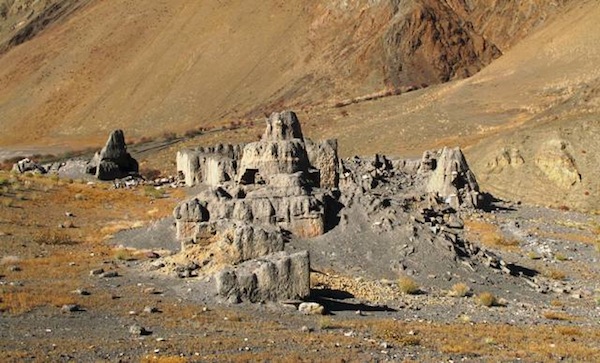
In Tibet the stepped motif is called a 'Chorten', it is the most common element seen on pre-historic rock art, it's basis as in all 'stargate cultures' is that of the zodiacal light triangular cone seen before sunrise or after sunset in conjunction with the ecliptic plane, it has the asociation of being the portal into the upper Heavenly realms or the Underworld, this can be seen in the example below.
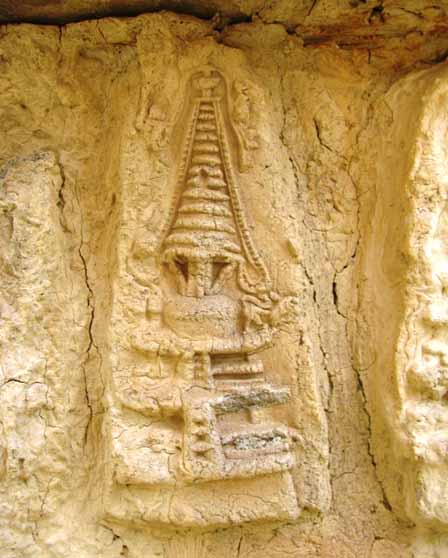
It will be seen that often Chorten were seen in terms of a triad, especially in the early Buddhist period associated with the three main principles of such, this is due to identification with three principle points of the horizon were the zodiacal light or mystical mountain will be seen, the two solstice points and the midpoint of the equinox, in Sumeria these are clearly identified as the three main portal points across the horizons, this would be the same in Tibet.
As the mountain directly equates with the ecliptic plane, then the sun, moon and plants will also be seen to rise in conjunction, and the basis for the Buddhist stupa was from earlier depictions of the sun and moon above the Chorten, often seen in totemic form.
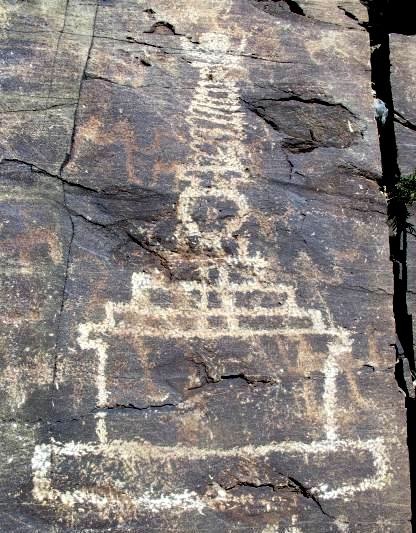
A lot of the images i shall post shall be from this excellent site on Tibet archaeology investigations, much of this is very recent and hitherto unseen.
www.tibetarchaeology.com...
A fine example of the chorten triad is seen on a gold death mask from the Guge burial, each with a solar symbol above it, which would go on to become the stupa.
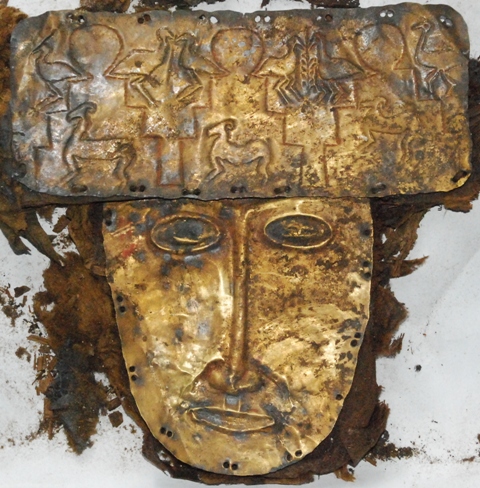
This leads on to the fact that the portal points across the horizons were the key element in afterlife belief, in Tibet this in conjunction with a prehistoric tradition of standing stones;
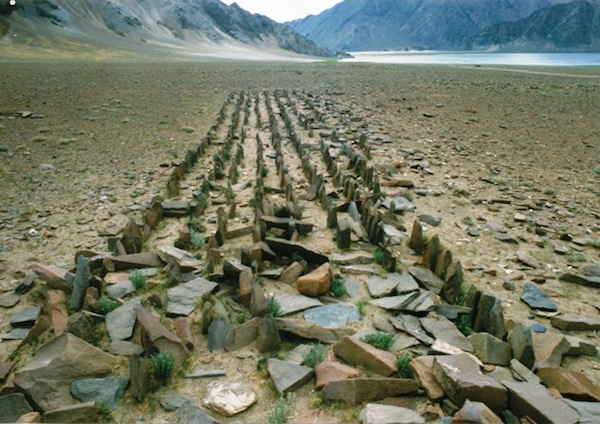
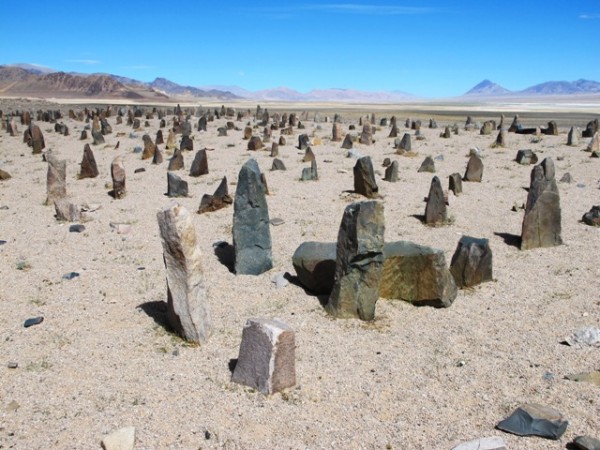
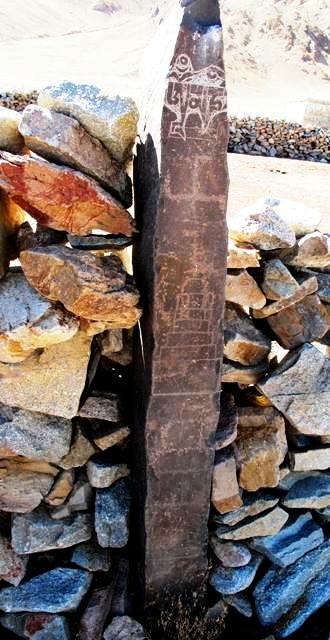
www.tibetarchaeology.com...
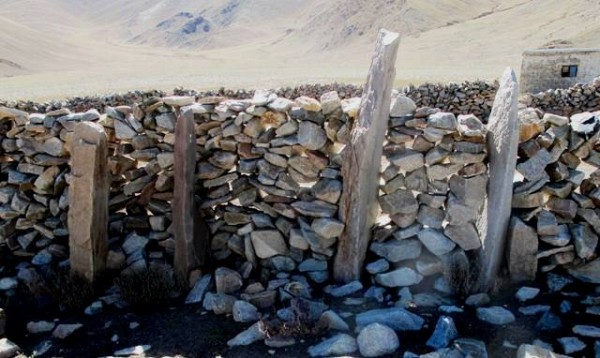
One sees then an interconnected system of pathways and grids upon the landscape, in conjunction with pathways across the Heavens.
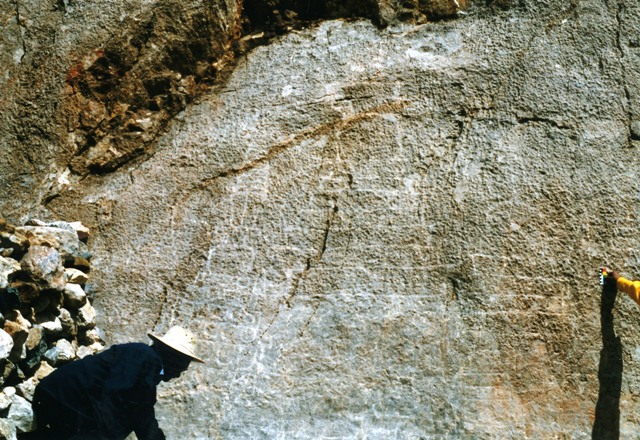
The primary figure associated with this beleif system is that of the Khyung, the flying eagle/man/demon, a figure that was also seen in connection with the 'Stargates of Iran'

The outstretched arms of the figure can often be seen holding a serpent, the importance of this is that as seen in Iran, this is the means of transition across the horizons, serpents function as passageways or wormholes, if considered in terms of astro-physics and translation across event horizons.
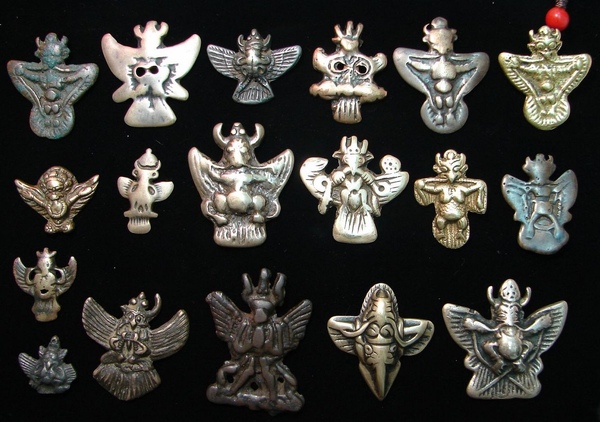
The third highly important element is that of the Dorje, which is a thunderbolt weapon, this is often seen describing the cardinal directions in symbolism, and it may have played some role in opening them and facilitating transition, in connection with the flying Khyung it is highly reminiscent of the 'flood-strom' weapon of the Sumerians which i wrote of here;
www.abovetopsecret.com...

It's power would be associated with serpents;
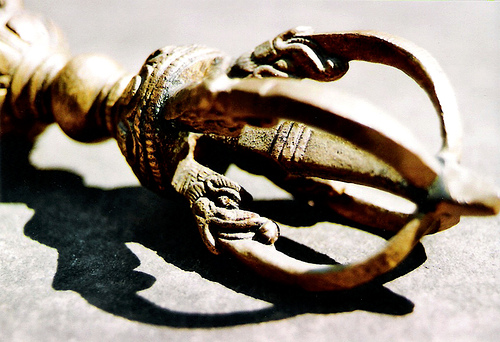
In early rock art enigmatic little figures are seen in conjunction with the Dorje;
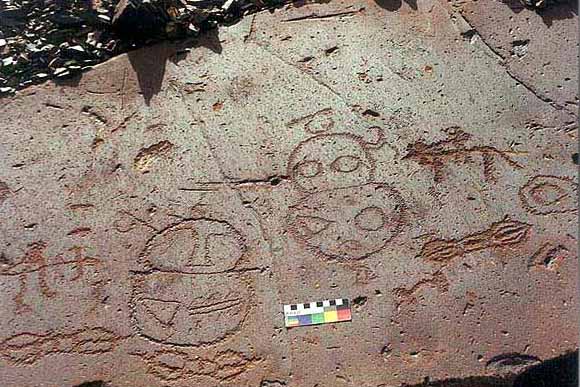

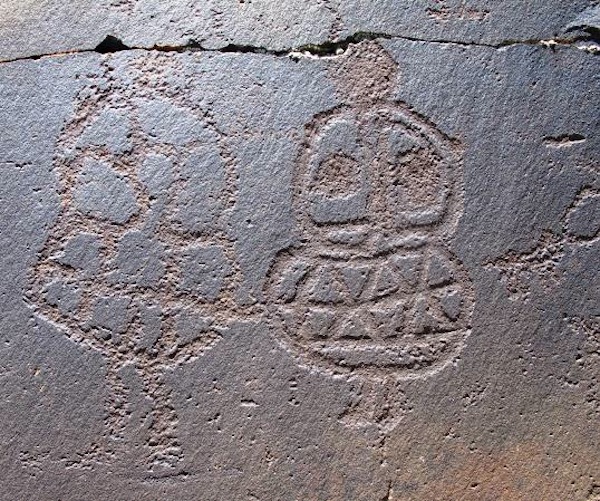
The author of the archeaology site refers to these figures as 'mascoids', but it is difficult to say what they actually represent, in some regards they are similar to the Australian Wandinja.
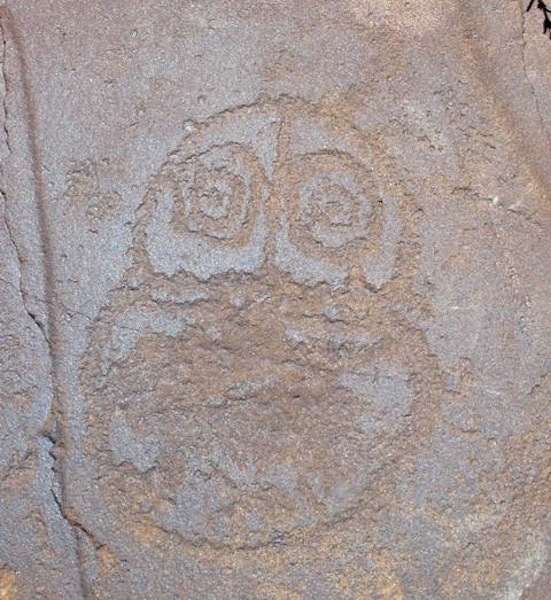
admin note:unless specifically indicated otherwise all the images in this thread are copyright John Vincent Bellezza and sourced from www.tibetarchaeology.com... asianart.com... asianart.com...
www.abovetopsecret.com...
The premise for this model is of a stepped/layered thought system that formed the basis for these cultures, involving progression from natural observance, though to metaphorical/sexual/mythological interpretation, then to cosmological with upper levels involving advanced mathamatical/technological potentialities.

The basic marker then for civilizations that were developed along this model is that of the stepped symbol and that is were we shall begin for Tibet.

In Tibet the stepped motif is called a 'Chorten', it is the most common element seen on pre-historic rock art, it's basis as in all 'stargate cultures' is that of the zodiacal light triangular cone seen before sunrise or after sunset in conjunction with the ecliptic plane, it has the asociation of being the portal into the upper Heavenly realms or the Underworld, this can be seen in the example below.

It will be seen that often Chorten were seen in terms of a triad, especially in the early Buddhist period associated with the three main principles of such, this is due to identification with three principle points of the horizon were the zodiacal light or mystical mountain will be seen, the two solstice points and the midpoint of the equinox, in Sumeria these are clearly identified as the three main portal points across the horizons, this would be the same in Tibet.
As the mountain directly equates with the ecliptic plane, then the sun, moon and plants will also be seen to rise in conjunction, and the basis for the Buddhist stupa was from earlier depictions of the sun and moon above the Chorten, often seen in totemic form.

A lot of the images i shall post shall be from this excellent site on Tibet archaeology investigations, much of this is very recent and hitherto unseen.
www.tibetarchaeology.com...
A fine example of the chorten triad is seen on a gold death mask from the Guge burial, each with a solar symbol above it, which would go on to become the stupa.

This leads on to the fact that the portal points across the horizons were the key element in afterlife belief, in Tibet this in conjunction with a prehistoric tradition of standing stones;
The alignment of the standing stones and buildings of Upper Tibetan necropoli hints at a high level of astronomical discernment. At minimum, the rising and setting of the sun over the course of the year was plotted at these sites. More complex lunar and sidereal calculations may also be incumbent in the spatial arrangements of the necropoli, but this is difficult to establish in any scientifically verifiable manner. In addition to the erected stones, many sites have long slabs of stone embedded in the ground edgewise to form a grid pattern covering as much as 800 m²

The necropoli feature quadrate arrays of standing stones aligned in the cardinal directions or in the intermediate directions. These concourses contain between 100 and 3000 miniature stelae or menhirs. Just west of each field of standing stones is an above-ground building aligned in the same manner. These specially built structures functioned as mortuary temples and tombs.

Given the intricate architecture of the Upper Tibetan necropoli, we can surmise that a complex range of ritual activities were once conducted at them. Some of the Tibetan archaic funerary texts I have worked on may provide an indication as to the nature of these functions, but this is still speculative. The texts do indeed mention long-stones (rdo-ring) and erected stone registers (tho) used in the mystic reconditioning of the souls of the deceased, as a prelude to their entry into the ancestral afterlife

According to the pastoralist communities of upland Tibet, the pillars erected within quadrate enclosures emerged at the very beginning of the universe. While this may be quite an exaggeration, the oral tradition does signal great age. Timbers removed from inside a wall of a mausoleum built with an analogous enclosure have been dated to circa the 5th century CE, furnishing us with a scientific perspective on which to build. Some walled-in pillars are liable to extend much further back in time perhaps to the first half of the first millennium BCE
www.tibetarchaeology.com...

One sees then an interconnected system of pathways and grids upon the landscape, in conjunction with pathways across the Heavens.

The primary figure associated with this beleif system is that of the Khyung, the flying eagle/man/demon, a figure that was also seen in connection with the 'Stargates of Iran'

The outstretched arms of the figure can often be seen holding a serpent, the importance of this is that as seen in Iran, this is the means of transition across the horizons, serpents function as passageways or wormholes, if considered in terms of astro-physics and translation across event horizons.

The third highly important element is that of the Dorje, which is a thunderbolt weapon, this is often seen describing the cardinal directions in symbolism, and it may have played some role in opening them and facilitating transition, in connection with the flying Khyung it is highly reminiscent of the 'flood-strom' weapon of the Sumerians which i wrote of here;
www.abovetopsecret.com...

It's power would be associated with serpents;

In early rock art enigmatic little figures are seen in conjunction with the Dorje;



The author of the archeaology site refers to these figures as 'mascoids', but it is difficult to say what they actually represent, in some regards they are similar to the Australian Wandinja.

admin note:unless specifically indicated otherwise all the images in this thread are copyright John Vincent Bellezza and sourced from www.tibetarchaeology.com... asianart.com... asianart.com...
edit on 2-13-2013 by Springer because: (no reason given)
edit on 2-13-2013 by Springer because: (no reason
given)
edit on 2-13-2013 by Springer because: (no reason given)
We have then established a few basic understandings, and these can be used in looking at the representations of the Chorten, the Khyung and the Dorje
in Tibetan amulets or Thogchags
, with referance to the very fine collection assembled here;
www.tcoletribalrugs.com...
I will just note a few interesting points, as the site itselfs gives good description for all;
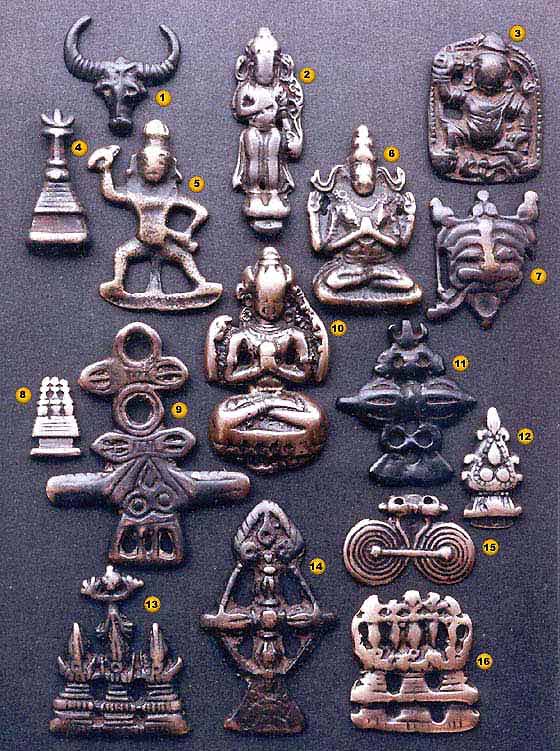
15. Dorje with spiral energy whirls. These spirals portray fields of power generated by the dorje,
Interesting with regards to my suggestion that the Dorje had the capacity for being an opener of ways, as it were.
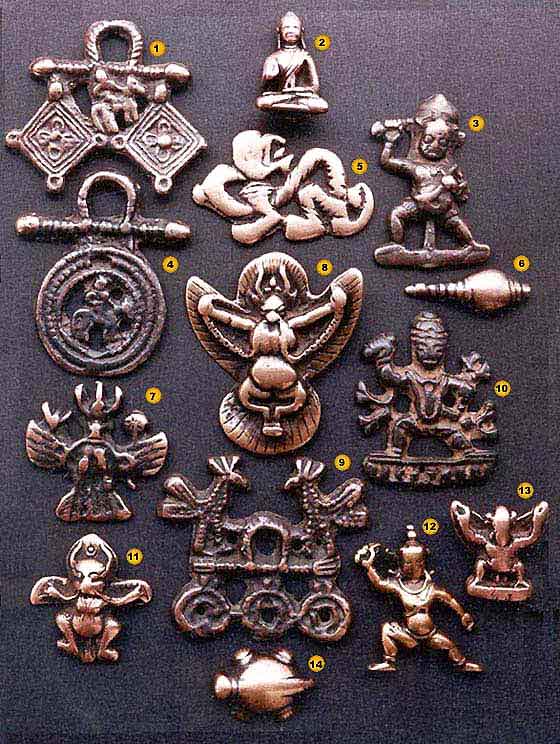
9. Plaque adorned by two khyungs
Interesting in that one sees the concept of the triple portal reconciled into the of an essential singular, in connection with the Khyung.
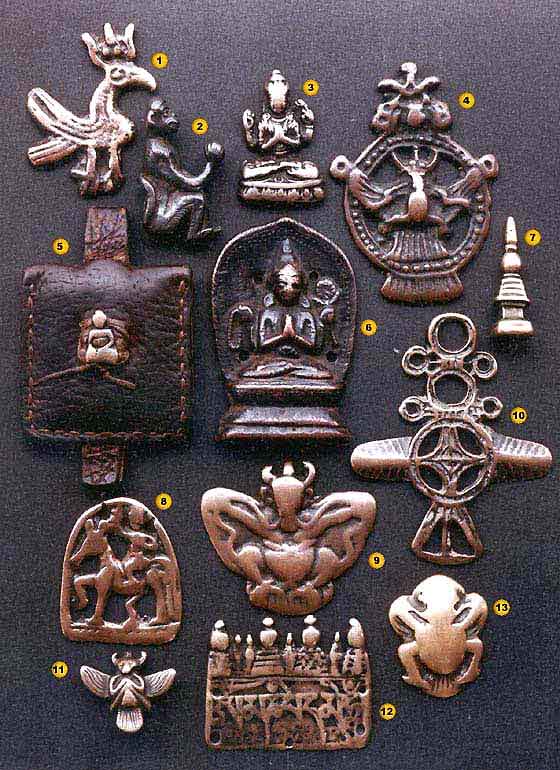
[A superb early Khyung, this squat figure radiates a raw vitality. Note the wriggling serpent it grasps in its mouth. The serpent represents the water spirits and their containment
The association of the serpent of transition with water is worth noting, but like i said just a few general points i can make on these as the artifacts speak for themselves.
The piece that first got my attention though and prompted this investigation was this one though,
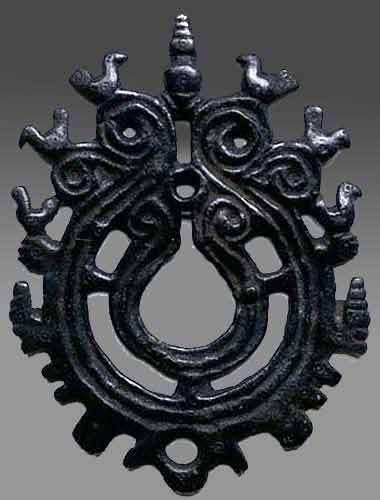
A rare sacred Tibetan Fibula, probably used in Pre-Buddhist Bon religious rites. The top half depicts six birds flanking a sacred vase which rest on energy spirals on the outer ring. Below this are two Bon stupas and stylized motifs. The sacred vase or tsebum has its origins in ancient Bonpo long-life and fortune-bestowing rituals
This was because it had remarkable similarity to a piece from Luristan in Iran, which would date back a couple of thousand years earlier, as i've noted there is similar basis for these Tibetan beliefs in ancient Iran;
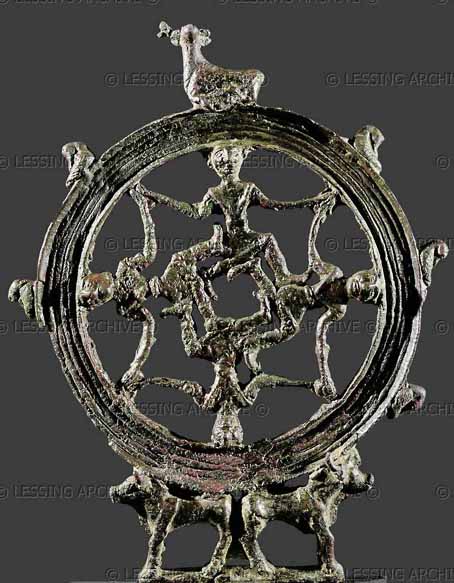
Any cultural transmission from ancient Iran to Tibet would of course be through Indus valley civilization, and i've noted elsewhere the similaraties between the piece from Luristan and Hindu iconography;
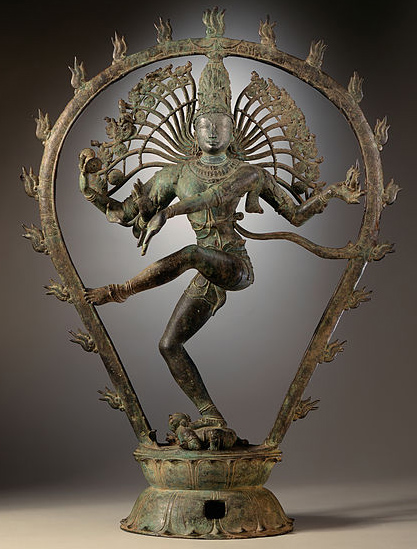
There is similarity also in the manner in which the appendages on the shoulders of Shiva reflect ways in which the 'flood-storm' weapon of the Sumerians could be represented, this comes full circle when the Dorje thunderbolt weapon is seen on this Tibetan cosmological fibula, with the Khyung seen atop it
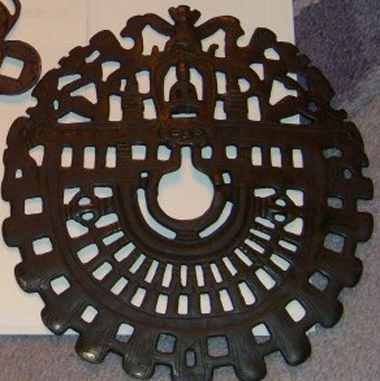
So the implication then is that possibly these traditions arrived in Tibet at an early date from as far away as Iran, though given the strength and recurrence of these motifs in early Tibetan iconography it could be argued they are indigenous rather than imported, but certainly there appears to be common cultural elements with Tibet and ancient Iran, and by extension Sumeria.
I'll also note here that in Tibet, as elsewhere, the swastika was based upon the rotation of Ursa Major around the Celestial North Pole, at four points of the year, at the solstices and equinoxs it would be seen to rise thus, whilst also of course undergoing such rotation on the daily basis as well as marking the four yearly quarters.
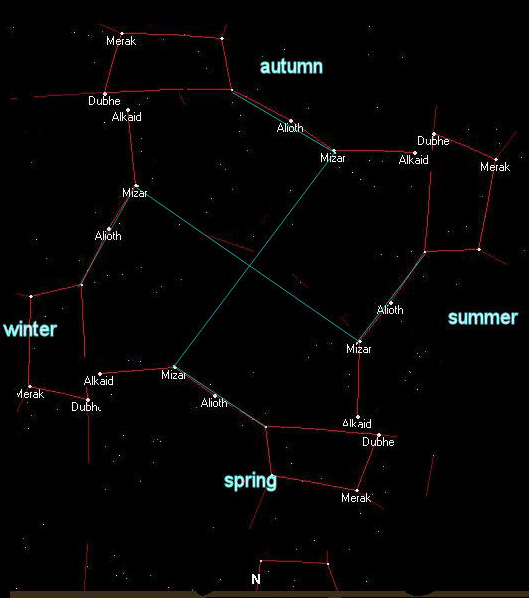
, with referance to the very fine collection assembled here;
www.tcoletribalrugs.com...
I will just note a few interesting points, as the site itselfs gives good description for all;

15. Dorje with spiral energy whirls. These spirals portray fields of power generated by the dorje,
Interesting with regards to my suggestion that the Dorje had the capacity for being an opener of ways, as it were.

9. Plaque adorned by two khyungs
Interesting in that one sees the concept of the triple portal reconciled into the of an essential singular, in connection with the Khyung.

[A superb early Khyung, this squat figure radiates a raw vitality. Note the wriggling serpent it grasps in its mouth. The serpent represents the water spirits and their containment
The association of the serpent of transition with water is worth noting, but like i said just a few general points i can make on these as the artifacts speak for themselves.
The piece that first got my attention though and prompted this investigation was this one though,

A rare sacred Tibetan Fibula, probably used in Pre-Buddhist Bon religious rites. The top half depicts six birds flanking a sacred vase which rest on energy spirals on the outer ring. Below this are two Bon stupas and stylized motifs. The sacred vase or tsebum has its origins in ancient Bonpo long-life and fortune-bestowing rituals
This was because it had remarkable similarity to a piece from Luristan in Iran, which would date back a couple of thousand years earlier, as i've noted there is similar basis for these Tibetan beliefs in ancient Iran;

Any cultural transmission from ancient Iran to Tibet would of course be through Indus valley civilization, and i've noted elsewhere the similaraties between the piece from Luristan and Hindu iconography;

There is similarity also in the manner in which the appendages on the shoulders of Shiva reflect ways in which the 'flood-storm' weapon of the Sumerians could be represented, this comes full circle when the Dorje thunderbolt weapon is seen on this Tibetan cosmological fibula, with the Khyung seen atop it

So the implication then is that possibly these traditions arrived in Tibet at an early date from as far away as Iran, though given the strength and recurrence of these motifs in early Tibetan iconography it could be argued they are indigenous rather than imported, but certainly there appears to be common cultural elements with Tibet and ancient Iran, and by extension Sumeria.
I'll also note here that in Tibet, as elsewhere, the swastika was based upon the rotation of Ursa Major around the Celestial North Pole, at four points of the year, at the solstices and equinoxs it would be seen to rise thus, whilst also of course undergoing such rotation on the daily basis as well as marking the four yearly quarters.

edit on 28-9-2012 by Kantzveldt because: (no reason given)
reply to post by hp1229
Thanks, there is very little of this that is commonly known or understood, with regards to the Heavely origins of these beliefs...things will probably stay that way.
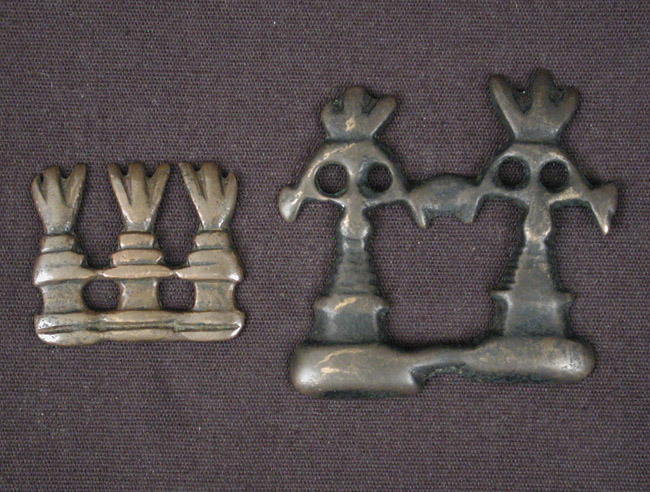
www.asianart.com...
Thanks, there is very little of this that is commonly known or understood, with regards to the Heavely origins of these beliefs...things will probably stay that way.

These thokchas also depict early variants of Bon shrines, and were cast not later than 1200, if not considerably earlier. The trio of shrines on the left consists of five tiers resting on a thin base. In the Bon tradition, these graduated tiers symbolize the five elements (space, air, fire, water, and earth) that compose the universe. These stepped structures are topped by three long points, which in Bon are referred to as, ‘the horns of the bird, the sword of the bird’ (charu chatri). This finial symbolizes the superlative nature of the Bon religion and its heavenly origin.
www.asianart.com...
edit on 2-13-2013 by Springer because: (no reason given)
reply to post by Kantzveldt
You will definitely find this interestering:
The Lost Truth
I firmly believe, from my OWN experiences, that there is a "literal" projection of the mythological / symbolical traditions to our own human life...in other words, today's science has barely scratched the surface of the inner ocean, but it cannot delve deeper due to it's mental origin...there were ancient "cartographers" of the inner plane, for whom travelling through that plane was an inner science, fully developed to the maximum. That is the ONE secret behind all religious practices of the past. If you apply this inner science for example to ancient egypt and the pyramids, then their purpose has a "literal" (aka mental) projection of their fuction, which is the one that the egyptians never denied from the beggining: A vessel to guide the watcher inside the inner plane of "afterlife" and "eternity". I wonder for how long we will still try to "industrialise" and scientify their clearly stated purpose and fail to see the obvious truth...
You will definitely find this interestering:
The Lost Truth
I firmly believe, from my OWN experiences, that there is a "literal" projection of the mythological / symbolical traditions to our own human life...in other words, today's science has barely scratched the surface of the inner ocean, but it cannot delve deeper due to it's mental origin...there were ancient "cartographers" of the inner plane, for whom travelling through that plane was an inner science, fully developed to the maximum. That is the ONE secret behind all religious practices of the past. If you apply this inner science for example to ancient egypt and the pyramids, then their purpose has a "literal" (aka mental) projection of their fuction, which is the one that the egyptians never denied from the beggining: A vessel to guide the watcher inside the inner plane of "afterlife" and "eternity". I wonder for how long we will still try to "industrialise" and scientify their clearly stated purpose and fail to see the obvious truth...
wow! this is fascinating. thanks so much for this post! lots to review...
reply to post by Karmakosmik
I think you're right and it's a very important point, were i see things in terms of levels of interpretation, the key symbolic marker the stepped monument representing establishment, what you suggest would be the most fundamental level, beneath and supportive of even that of the natural world itself, indeed giving rise to it...everything is pattern and relationship.
I think you're right and it's a very important point, were i see things in terms of levels of interpretation, the key symbolic marker the stepped monument representing establishment, what you suggest would be the most fundamental level, beneath and supportive of even that of the natural world itself, indeed giving rise to it...everything is pattern and relationship.
reply to post by Kantzveldt
It's really mind blowing in a way...it's like you realise that the individual mind is like a candle that is constantly lighten up by the inner sun...it changes your own "orientation" in a way within existence...and the more you realise this inner origin the more you are able to realise the inner streams of energy and what myths and symbols convey. And rather than "tuning" you in the past, this process tunes your inner being to the present...If this paradigm shift isn't at total contrast with our current modern way of living, (and usually with our modern understanding of "religion") then i don't know what it is...
As ancient texts write, "in the world of the spirit, there is only one day..."
It's really mind blowing in a way...it's like you realise that the individual mind is like a candle that is constantly lighten up by the inner sun...it changes your own "orientation" in a way within existence...and the more you realise this inner origin the more you are able to realise the inner streams of energy and what myths and symbols convey. And rather than "tuning" you in the past, this process tunes your inner being to the present...If this paradigm shift isn't at total contrast with our current modern way of living, (and usually with our modern understanding of "religion") then i don't know what it is...
As ancient texts write, "in the world of the spirit, there is only one day..."
Paul LaViolette, in his book "Genesis of the Cosmos", describes accurately the way ancient monuments and symbols were experienced by certain elits
of the past:
Ancient Egyptians must had viewed the Sphinx as a type of Dimensional Gate (or Stargate), like the monolithic stargate in Arthur's Clarke's 2001 space odyssey. Travelling symbolically through that gate to the underworld, they were moving from the visible world of the three dimensions to the higher dimensional level of the etheric plane. Although the duat was literally under the earth, this only constituted a metamphor which was intented to transmit the mental concept of that plane, which borders with our natural world and it lies "under" or "above" it, with the sense that it is not directly visible from our own world.
reply to post by Karmakosmik
That's true, the underlying symbol for transformation was the portal signified by the zodiacal light upon the horizon, which is just particles of dust seen in diminoshing perspective along the ecliptic plane, but this was a metaphor for the diffuse and illusory being the point of transition between the physical and spiritual realms, an intermediate highly charged point of being, to the Egyptians the Akhet, to the Tibetans the symbolism inherant in the Chorten, subsequently the stepped temples with stupa.
That's true, the underlying symbol for transformation was the portal signified by the zodiacal light upon the horizon, which is just particles of dust seen in diminoshing perspective along the ecliptic plane, but this was a metaphor for the diffuse and illusory being the point of transition between the physical and spiritual realms, an intermediate highly charged point of being, to the Egyptians the Akhet, to the Tibetans the symbolism inherant in the Chorten, subsequently the stepped temples with stupa.
reply to post by Kantzveldt
Thank you for sharing your research. Your efforts will not go unnoticed. My first thought was with regard to the fact we are very lucky that the in situ artifacts have survived - both time and invasion by China. I feel that Tibetans have an esoteric link to what we search for via archaeology. They have a sense of the heavens about them and I am sure the Chinese wanted to conquer the land and their people for more reasons than we know.
The Tibetans, from my experience seem to exude an air of Spirituality that belies their past - especially when you think of all the brutality the people have suffered. The fact that the standing artefacts are still standing is an awesome testament to their faith - let alone the natural elements.
Thank you again for a beautiful and thought provoking article.
Much Peace...
Thank you for sharing your research. Your efforts will not go unnoticed. My first thought was with regard to the fact we are very lucky that the in situ artifacts have survived - both time and invasion by China. I feel that Tibetans have an esoteric link to what we search for via archaeology. They have a sense of the heavens about them and I am sure the Chinese wanted to conquer the land and their people for more reasons than we know.
The Tibetans, from my experience seem to exude an air of Spirituality that belies their past - especially when you think of all the brutality the people have suffered. The fact that the standing artefacts are still standing is an awesome testament to their faith - let alone the natural elements.
Thank you again for a beautiful and thought provoking article.
Much Peace...
i'm sure their were little grey headed aliens screwing with early man.
back then you see a light moving in the sky, it's extra-terrestrial.
now, with so many planes, helicopters, satellites, hoaxes etc, you can't tell whats authentic and whats not.
back then you see a light moving in the sky, it's extra-terrestrial.
now, with so many planes, helicopters, satellites, hoaxes etc, you can't tell whats authentic and whats not.
Very interesting.
Another (very old) culture with intimations with star gate trails...
Reading also about Aborigines now, the 'Real People', and its not surprising they have similar iconography with Tibetans, as they also have significant similarities with native american tribes and Vedic practices and beliefs.
May be a reason why they say theyve been here since the beginning of time...and may also be a further branch of research to your very interesting thread topic!
Thanks!
LOVE∞
mayallsoulsbefree*
Another (very old) culture with intimations with star gate trails...
Reading also about Aborigines now, the 'Real People', and its not surprising they have similar iconography with Tibetans, as they also have significant similarities with native american tribes and Vedic practices and beliefs.
May be a reason why they say theyve been here since the beginning of time...and may also be a further branch of research to your very interesting thread topic!
Thanks!
LOVE∞
mayallsoulsbefree*
reply to post by Kantzveldt
Thanks once again for your suggestive thread, that gives each of us a chance to see how we feel about what we see. I am sure that it is this way we will awaken to the knowledge of our ancient way. I thought I would add this video I used to have it and the whole doc lasted about 45 mins but I cant find it anywhere. But I was amazed at how weird these towers were and how different they are to what we normally see in Tibet and the general area. Give it a glimpse as it really is worthwhile, salutations to the french lady that made it possible.Maybe someone can find the whole doc again.Best wishes.
Thanks once again for your suggestive thread, that gives each of us a chance to see how we feel about what we see. I am sure that it is this way we will awaken to the knowledge of our ancient way. I thought I would add this video I used to have it and the whole doc lasted about 45 mins but I cant find it anywhere. But I was amazed at how weird these towers were and how different they are to what we normally see in Tibet and the general area. Give it a glimpse as it really is worthwhile, salutations to the french lady that made it possible.Maybe someone can find the whole doc again.Best wishes.
You will see what you want to see....even if stargates are based on a book turned into a movie turned into a TV series.
My point is without that book, you would not have thread because without the fantasy of a stargate you'd be guessing as to what the symbolism means... like you are now.
My point is without that book, you would not have thread because without the fantasy of a stargate you'd be guessing as to what the symbolism means... like you are now.
You will see what you want to see....even if stargates are based on a book turned into a movie turned into a TV series.
My point is without that book, you would not have thread because without the fantasy of a stargate you'd be guessing as to what the symbolism means... like you are now.
My point is without that book, you would not have thread because without the fantasy of a stargate you'd be guessing as to what the symbolism means... like you are now.
You will see what you want to see....even if stargates are based on a book turned into a movie turned into a TV series.
My point is without that book, you would not have thread because without the fantasy of a stargate you'd be guessing as to what the symbolism means... like you are now.
My point is without that book, you would not have thread because without the fantasy of a stargate you'd be guessing as to what the symbolism means... like you are now.
Excellent work!!
Its true...these are designed to convey the underlying energy interactions everywhere around us...the San Graal or Holy grail. The blackness...Chem..its hard to explain. As a picture is worth a thousand words, these are worth much much more...its a scientific set of principals being communicated through art...
I wish I could hug you
Keep up the good work...you are absolutely on the right track!!
Edit...sorry to leave you out Karmakosmik...great contributions...ahhh it's not hopeless...
Its true...these are designed to convey the underlying energy interactions everywhere around us...the San Graal or Holy grail. The blackness...Chem..its hard to explain. As a picture is worth a thousand words, these are worth much much more...its a scientific set of principals being communicated through art...
I wish I could hug you
Keep up the good work...you are absolutely on the right track!!
Edit...sorry to leave you out Karmakosmik...great contributions...ahhh it's not hopeless...
edit on 9/28/2012 by Drala because: (no reason given)
Originally posted by pacifier2012
You will see what you want to see....even if stargates are based on a book turned into a movie turned into a TV series.
My point is without that book, you would not have thread because without the fantasy of a stargate you'd be guessing as to what the symbolism means... like you are now.
You have that backwards...the books and tv series are based on these...facepalm...back to the hopeless feeling again...who cares what they call it...stargate or not...its the projection the geometry conveys to your third eye, and you look for similar patterns around you...this # is invisible to your normal ocular vision..
PS you double posted...
Look up MEME...CULTURAL MEME...the OP would have a thread either way
edit on 9/28/2012 by Drala because: (no reason given)
new topics
-
Ben Habib has Left Reform UK
Regional Politics: 1 hours ago -
Turkey Day Rhyme…
Short Stories: 1 hours ago -
Can someone please translate Biden's speech?
US Political Madness: 2 hours ago -
NIH Chief Confesses COVID Initiatives Were "Completely Made Up " OMG Investigates
Health & Wellness: 2 hours ago -
Awesome Dip Recipe
Food and Cooking: 5 hours ago -
Vladimir Putin's speech at the meeting of the CSTO Collective Security Council
World War Three: 6 hours ago -
Traveling the world with no passport
Social Issues and Civil Unrest: 10 hours ago
top topics
-
Happy Thanksgiving to ATS
General Chit Chat: 14 hours ago, 9 flags -
NIH Chief Confesses COVID Initiatives Were "Completely Made Up " OMG Investigates
Health & Wellness: 2 hours ago, 9 flags -
Traveling the world with no passport
Social Issues and Civil Unrest: 10 hours ago, 6 flags -
Vladimir Putin's speech at the meeting of the CSTO Collective Security Council
World War Three: 6 hours ago, 6 flags -
Can someone please translate Biden's speech?
US Political Madness: 2 hours ago, 6 flags -
Awesome Dip Recipe
Food and Cooking: 5 hours ago, 4 flags -
Ben Habib has Left Reform UK
Regional Politics: 1 hours ago, 3 flags -
Turkey Day Rhyme…
Short Stories: 1 hours ago, 2 flags
active topics
-
Vladimir Putin's speech at the meeting of the CSTO Collective Security Council
World War Three • 28 • : GENERAL EYES -
Ben Habib has Left Reform UK
Regional Politics • 3 • : gortex -
Turkey Day Rhyme…
Short Stories • 1 • : FullHeathen -
Can someone please translate Biden's speech?
US Political Madness • 6 • : Oldcarpy2 -
Happy Thanksgiving to ATS
General Chit Chat • 12 • : JsnJln -
Trump could make a peaceful American Revolution
US Political Madness • 11 • : stu119 -
D.B. Cooper mystery may be solved
General Conspiracies • 25 • : Arbitrageur -
Petition Calling for General Election at 564,016 and rising Fast
Political Issues • 108 • : angelchemuel -
Awesome Dip Recipe
Food and Cooking • 3 • : Flyingclaydisk -
Trump Presidential Transition Team will not use GSA or Government entities to come to DC
US Political Madness • 20 • : angelchemuel
